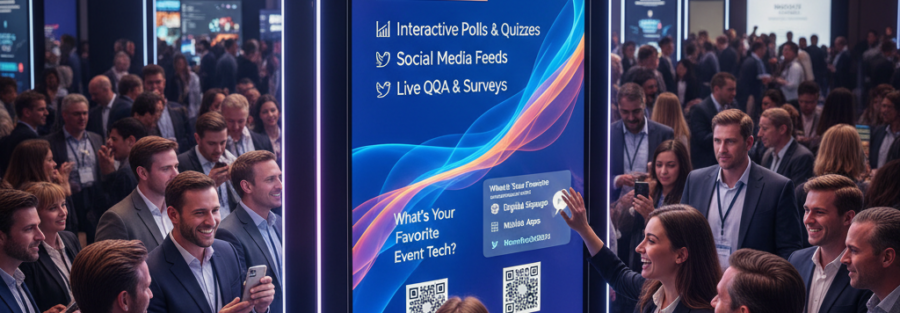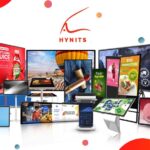How to Engage Your Audience at Events Using Digital Signage Products?
Organizing an event today requires more than a simple stage and audience. The success of any event lies in how effectively the product and its uses are showcased to attendees. Digital signage products make this possible by combining dynamic visuals, interactive engagement, and real-time communication. Each product serves a unique purpose in the event flow, from creating a strong first impression to leaving attendees with a lasting takeaway. Below is a detailed look at how digital signage products can be used throughout an event, with their exact uses and features explained.
The journey begins at the entrance. The first impression of an event sets the tone for what follows, and a Floor-Standing Digital Display is perfect for this purpose.
Use: It welcomes attendees, guides them with schedules, and introduces the product in an eye-catching way.
Features: Slim design, mobility, high-brightness screens, and the ability to update content remotely. Unlike static posters, these displays can run looping videos or animations, instantly engaging visitors and drawing their attention to the main attraction—the product.
showcase Products and Presentation
At the heart of the venue lies the main stage, where the product needs to be highlighted as the centerpiece. A LED Video Wall works best here.
Use: To showcase product demo videos, live presentations, and explainer animations.
Features: Seamless large-screen display, ultra-high definition visuals, customizable sizes, and dynamic video support. These walls create an immersive environment where every detail of the product’s features and real-world applications can be magnified, ensuring the entire audience understands the product’s value.
Explore Specifications
For deeper product exploration, an Interactive Touch Panel is the ideal choice.
Use: Allowing attendees to interact with the product’s details, explore specifications, and view its uses in different scenarios.
Features: Multi-touch capability, smooth writing and annotation, wireless screen sharing, and compatibility with multiple file formats. This makes complex product features easy to understand, as visitors can self-navigate through digital brochures, interactive infographics, and case studies right on the panel.
Wayfinding
In large events, it is crucial to help people navigate smoothly. Wayfinding Digital Kiosks serve this purpose effectively.
Use: Guiding attendees to different halls, demo stations, or breakout rooms.
Features: Interactive maps, real-time navigation updates, and customizable layouts. They not only reduce confusion but can also highlight where product showcases or demonstrations are happening, ensuring the product receives maximum visibility across the venue.
Announcement
Another critical use of digital signage is real-time communication. Wall-Mounted Digital Signage Displays are perfect tools for this.
Use: To share live updates, session changes, speaker introductions, or social media feeds.
Features: Cloud-based content management, split-screen layouts, and integration with live data sources. These displays keep guests informed at all times while still playing short product highlights in between announcements, ensuring that the product remains the focal point.
One of the strongest ways to connect with an audience is by showing product applications in real-life scenarios. Here, Commercial Displays or Video Walls can be used around the venue.
Use: To show where and how the product can be used—whether at home, in businesses, or in industrial setups.
Features: High brightness, vibrant colors, and flexible screen arrangements. Such displays allow you to create storytelling sequences where the product is shown solving problems or adding value, helping attendees imagine themselves using it.
Visitors in live surveys
Audience engagement is another key part of successful events. Interactive Kiosks provide the perfect solution.
Use: To involve visitors in live surveys, feedback collection, or quizzes about the product.
Features: Touch-enabled interface, QR code scanning, and integration with data collection apps. This interactivity keeps guests engaged and also generates useful insights about how they perceive the product and its potential.
Promoting Event Sponsors
For events involving sponsors or partners, Split-Screen Digital Signage Displays can help balance visibility.
Use: Promote sponsor branding without overshadowing the product.
Features: Ability to run multiple content streams at once, schedule-based content playlists, and professional-grade display clarity. While the product remains the main focus, sponsor recognition ensures business value for all stakeholders.
Training Sessions
In breakout rooms or smaller demo sessions, Interactive Flat Panels come into play.
Use: To explain detailed product features in training or hands-on workshops.
Features: Touch writing, digital whiteboarding, wireless sharing, and video conferencing support. These panels are excellent for presenters to break down product features clearly while also engaging participants directly with live annotations and demonstrations.
Finally, as the event concludes, the focus shifts to ensuring long-term connections with attendees. A Floor-Standing Display with QR Code Integration is ideal here.
Use: To display thank-you messages, share contact details, and provide digital brochures or trial sign-up forms.
Features: Portrait or landscape modes, easy content updates, and high-resolution screens. By making information accessible through QR codes, you avoid paper waste while still ensuring that attendees take the product information home with them.
Conclusion
In conclusion, digital signage transforms an ordinary event into a product-focused journey. Every product has its place: floor-standing displays for entrances, LED video walls for the main stage, touch panels for education, kiosks for navigation, wall-mounted screens for updates, and interactive systems for feedback. Each one highlights the product and its uses while leveraging features like interactivity, cloud-based management, and high-resolution visuals. By weaving these technologies into the event, organizers can ensure that their product is not only showcased but also remembered, understood, and valued long after the event is over.



